Professional Practice Taxation 6: Assignment Solution Analysis
VerifiedAdded on 2020/03/16
|9
|1393
|47
Homework Assignment
AI Summary
This document presents a comprehensive solution to a professional practice taxation assignment, addressing the calculation of net tax payable for individuals and analyzing the tax implications of various financial transactions. The assignment delves into issues such as the deductibility of travel expenses, superannuation contributions, child care expenses, and private living expenses, referencing relevant legislation, including the ITAA 1997, and case law, such as TR 95/9, FC of T v Hayley (1958), and TD 92/154. The solution also examines the tax liability of a minor employed for part-time administrative work, considering relevant taxation rulings and divisions of the ITAA. The analysis covers the determination of assessable income, allowable deductions, and the application of tax rules to specific scenarios, providing a detailed breakdown of the tax implications for both individuals and businesses. The assignment emphasizes the importance of understanding tax regulations and their practical application in real-world financial situations.
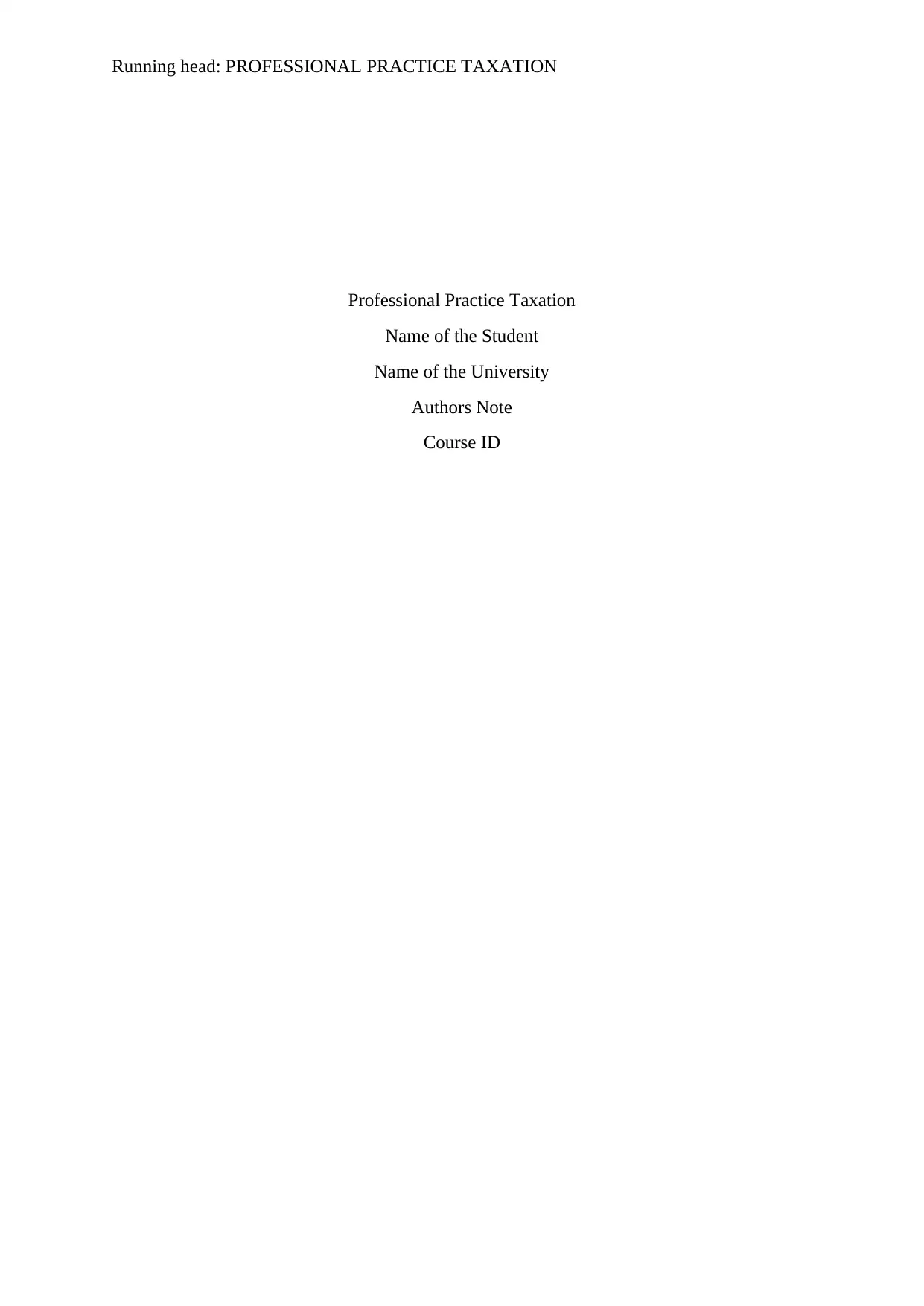
Running head: PROFESSIONAL PRACTICE TAXATION
Professional Practice Taxation
Name of the Student
Name of the University
Authors Note
Course ID
Professional Practice Taxation
Name of the Student
Name of the University
Authors Note
Course ID
Paraphrase This Document
Need a fresh take? Get an instant paraphrase of this document with our AI Paraphraser
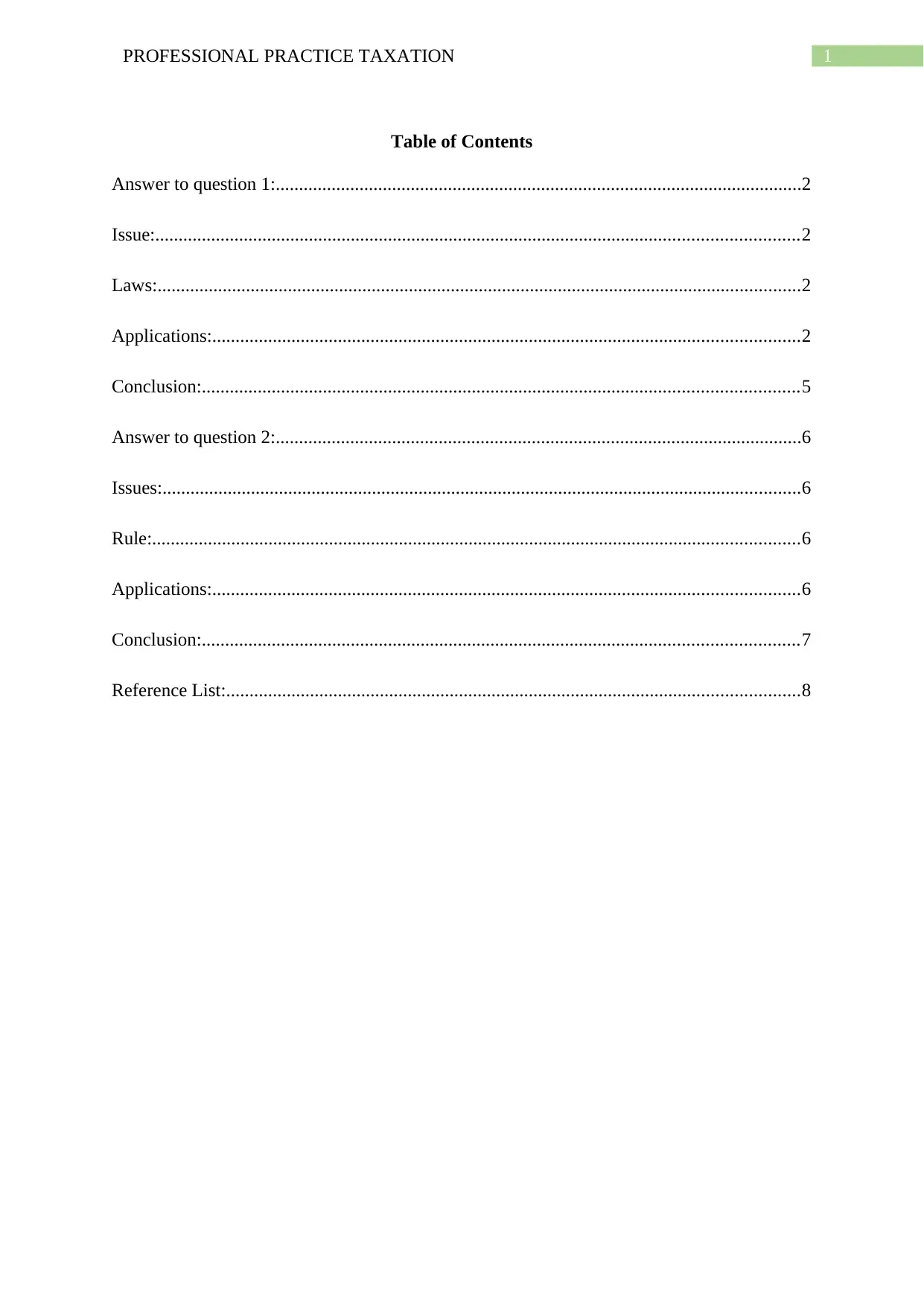
1PROFESSIONAL PRACTICE TAXATION
Table of Contents
Answer to question 1:.................................................................................................................2
Issue:..........................................................................................................................................2
Laws:..........................................................................................................................................2
Applications:..............................................................................................................................2
Conclusion:................................................................................................................................5
Answer to question 2:.................................................................................................................6
Issues:.........................................................................................................................................6
Rule:...........................................................................................................................................6
Applications:..............................................................................................................................6
Conclusion:................................................................................................................................7
Reference List:...........................................................................................................................8
Table of Contents
Answer to question 1:.................................................................................................................2
Issue:..........................................................................................................................................2
Laws:..........................................................................................................................................2
Applications:..............................................................................................................................2
Conclusion:................................................................................................................................5
Answer to question 2:.................................................................................................................6
Issues:.........................................................................................................................................6
Rule:...........................................................................................................................................6
Applications:..............................................................................................................................6
Conclusion:................................................................................................................................7
Reference List:...........................................................................................................................8
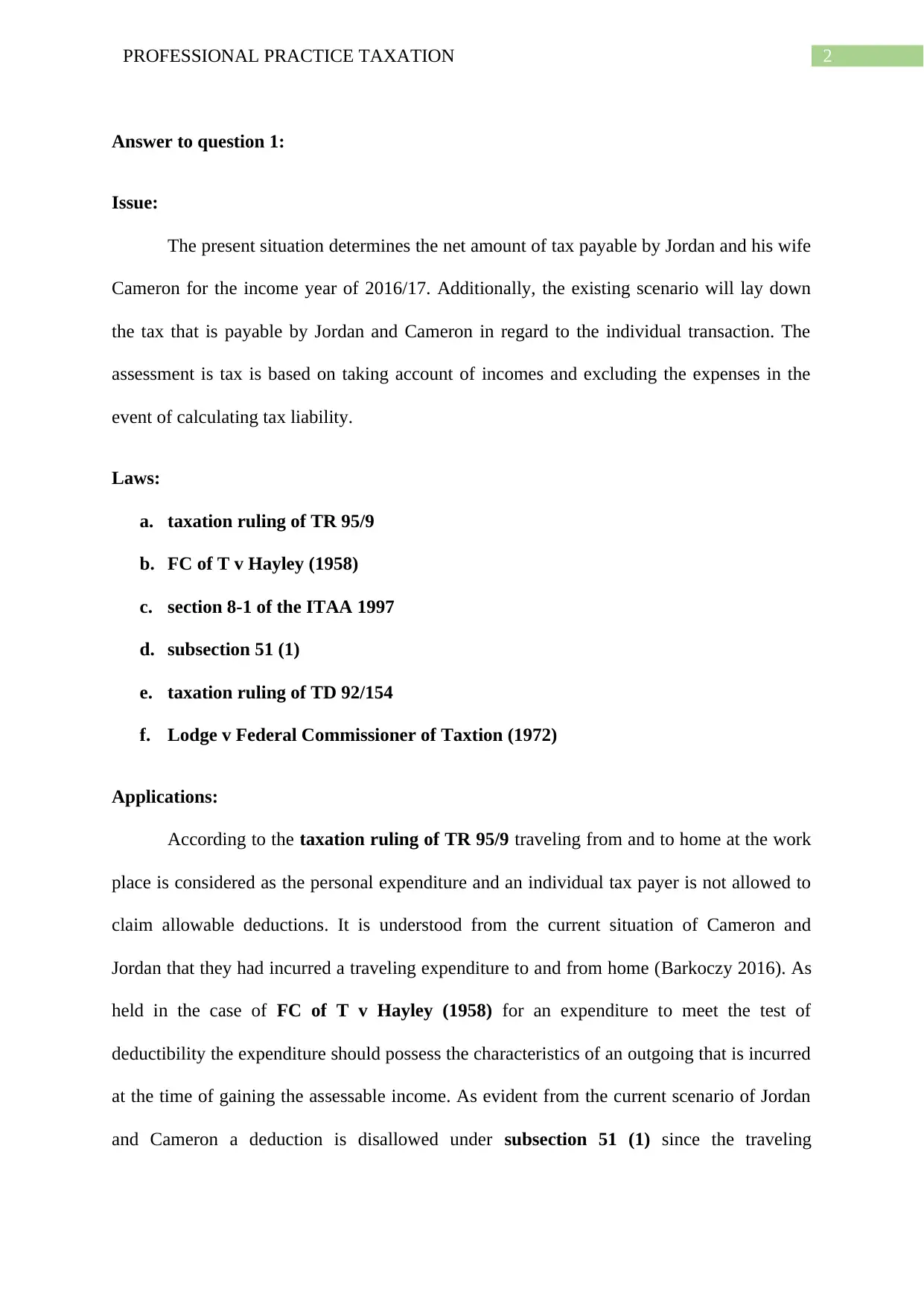
2PROFESSIONAL PRACTICE TAXATION
Answer to question 1:
Issue:
The present situation determines the net amount of tax payable by Jordan and his wife
Cameron for the income year of 2016/17. Additionally, the existing scenario will lay down
the tax that is payable by Jordan and Cameron in regard to the individual transaction. The
assessment is tax is based on taking account of incomes and excluding the expenses in the
event of calculating tax liability.
Laws:
a. taxation ruling of TR 95/9
b. FC of T v Hayley (1958)
c. section 8-1 of the ITAA 1997
d. subsection 51 (1)
e. taxation ruling of TD 92/154
f. Lodge v Federal Commissioner of Taxtion (1972)
Applications:
According to the taxation ruling of TR 95/9 traveling from and to home at the work
place is considered as the personal expenditure and an individual tax payer is not allowed to
claim allowable deductions. It is understood from the current situation of Cameron and
Jordan that they had incurred a traveling expenditure to and from home (Barkoczy 2016). As
held in the case of FC of T v Hayley (1958) for an expenditure to meet the test of
deductibility the expenditure should possess the characteristics of an outgoing that is incurred
at the time of gaining the assessable income. As evident from the current scenario of Jordan
and Cameron a deduction is disallowed under subsection 51 (1) since the traveling
Answer to question 1:
Issue:
The present situation determines the net amount of tax payable by Jordan and his wife
Cameron for the income year of 2016/17. Additionally, the existing scenario will lay down
the tax that is payable by Jordan and Cameron in regard to the individual transaction. The
assessment is tax is based on taking account of incomes and excluding the expenses in the
event of calculating tax liability.
Laws:
a. taxation ruling of TR 95/9
b. FC of T v Hayley (1958)
c. section 8-1 of the ITAA 1997
d. subsection 51 (1)
e. taxation ruling of TD 92/154
f. Lodge v Federal Commissioner of Taxtion (1972)
Applications:
According to the taxation ruling of TR 95/9 traveling from and to home at the work
place is considered as the personal expenditure and an individual tax payer is not allowed to
claim allowable deductions. It is understood from the current situation of Cameron and
Jordan that they had incurred a traveling expenditure to and from home (Barkoczy 2016). As
held in the case of FC of T v Hayley (1958) for an expenditure to meet the test of
deductibility the expenditure should possess the characteristics of an outgoing that is incurred
at the time of gaining the assessable income. As evident from the current scenario of Jordan
and Cameron a deduction is disallowed under subsection 51 (1) since the traveling
⊘ This is a preview!⊘
Do you want full access?
Subscribe today to unlock all pages.

Trusted by 1+ million students worldwide
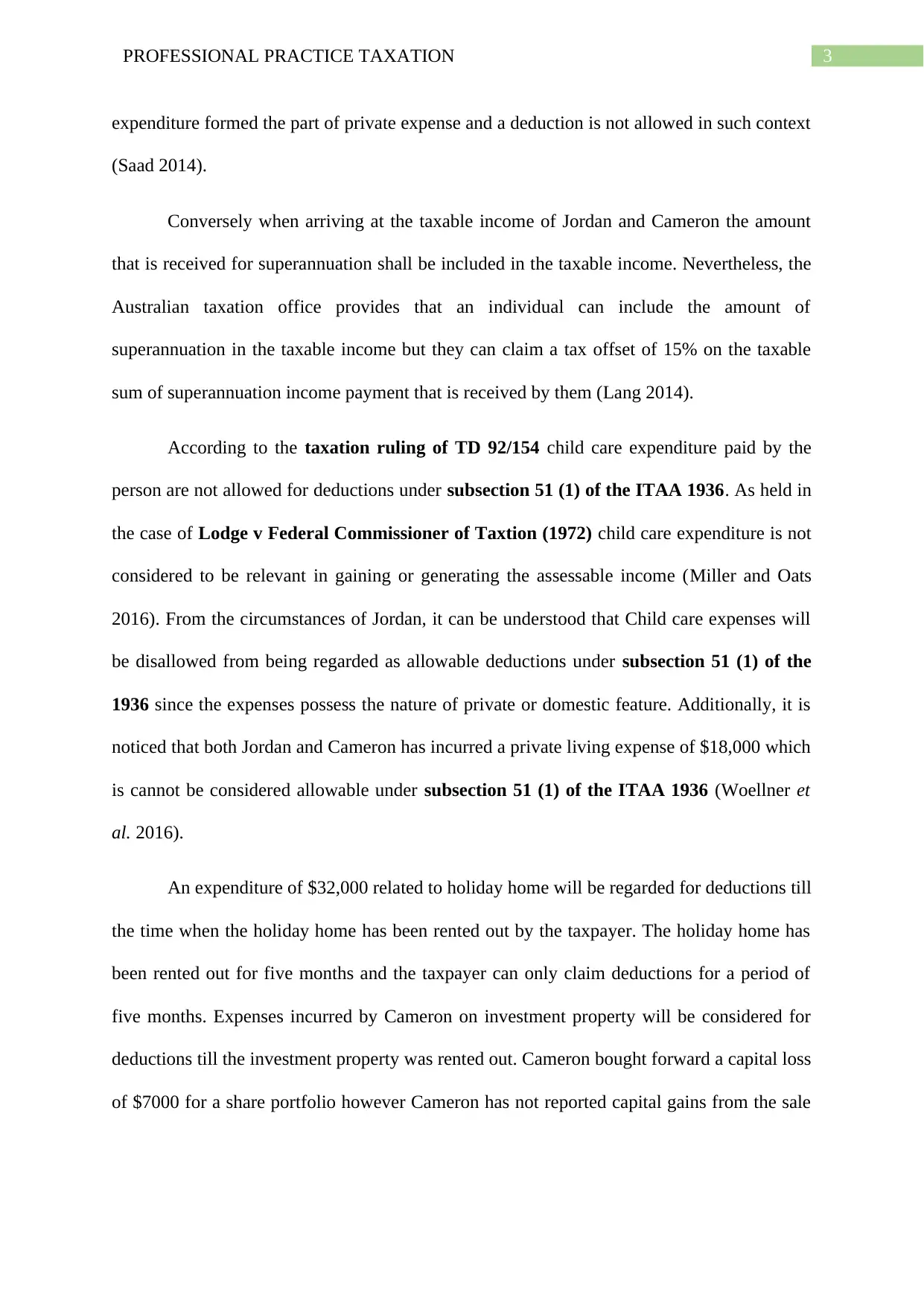
3PROFESSIONAL PRACTICE TAXATION
expenditure formed the part of private expense and a deduction is not allowed in such context
(Saad 2014).
Conversely when arriving at the taxable income of Jordan and Cameron the amount
that is received for superannuation shall be included in the taxable income. Nevertheless, the
Australian taxation office provides that an individual can include the amount of
superannuation in the taxable income but they can claim a tax offset of 15% on the taxable
sum of superannuation income payment that is received by them (Lang 2014).
According to the taxation ruling of TD 92/154 child care expenditure paid by the
person are not allowed for deductions under subsection 51 (1) of the ITAA 1936. As held in
the case of Lodge v Federal Commissioner of Taxtion (1972) child care expenditure is not
considered to be relevant in gaining or generating the assessable income (Miller and Oats
2016). From the circumstances of Jordan, it can be understood that Child care expenses will
be disallowed from being regarded as allowable deductions under subsection 51 (1) of the
1936 since the expenses possess the nature of private or domestic feature. Additionally, it is
noticed that both Jordan and Cameron has incurred a private living expense of $18,000 which
is cannot be considered allowable under subsection 51 (1) of the ITAA 1936 (Woellner et
al. 2016).
An expenditure of $32,000 related to holiday home will be regarded for deductions till
the time when the holiday home has been rented out by the taxpayer. The holiday home has
been rented out for five months and the taxpayer can only claim deductions for a period of
five months. Expenses incurred by Cameron on investment property will be considered for
deductions till the investment property was rented out. Cameron bought forward a capital loss
of $7000 for a share portfolio however Cameron has not reported capital gains from the sale
expenditure formed the part of private expense and a deduction is not allowed in such context
(Saad 2014).
Conversely when arriving at the taxable income of Jordan and Cameron the amount
that is received for superannuation shall be included in the taxable income. Nevertheless, the
Australian taxation office provides that an individual can include the amount of
superannuation in the taxable income but they can claim a tax offset of 15% on the taxable
sum of superannuation income payment that is received by them (Lang 2014).
According to the taxation ruling of TD 92/154 child care expenditure paid by the
person are not allowed for deductions under subsection 51 (1) of the ITAA 1936. As held in
the case of Lodge v Federal Commissioner of Taxtion (1972) child care expenditure is not
considered to be relevant in gaining or generating the assessable income (Miller and Oats
2016). From the circumstances of Jordan, it can be understood that Child care expenses will
be disallowed from being regarded as allowable deductions under subsection 51 (1) of the
1936 since the expenses possess the nature of private or domestic feature. Additionally, it is
noticed that both Jordan and Cameron has incurred a private living expense of $18,000 which
is cannot be considered allowable under subsection 51 (1) of the ITAA 1936 (Woellner et
al. 2016).
An expenditure of $32,000 related to holiday home will be regarded for deductions till
the time when the holiday home has been rented out by the taxpayer. The holiday home has
been rented out for five months and the taxpayer can only claim deductions for a period of
five months. Expenses incurred by Cameron on investment property will be considered for
deductions till the investment property was rented out. Cameron bought forward a capital loss
of $7000 for a share portfolio however Cameron has not reported capital gains from the sale
Paraphrase This Document
Need a fresh take? Get an instant paraphrase of this document with our AI Paraphraser
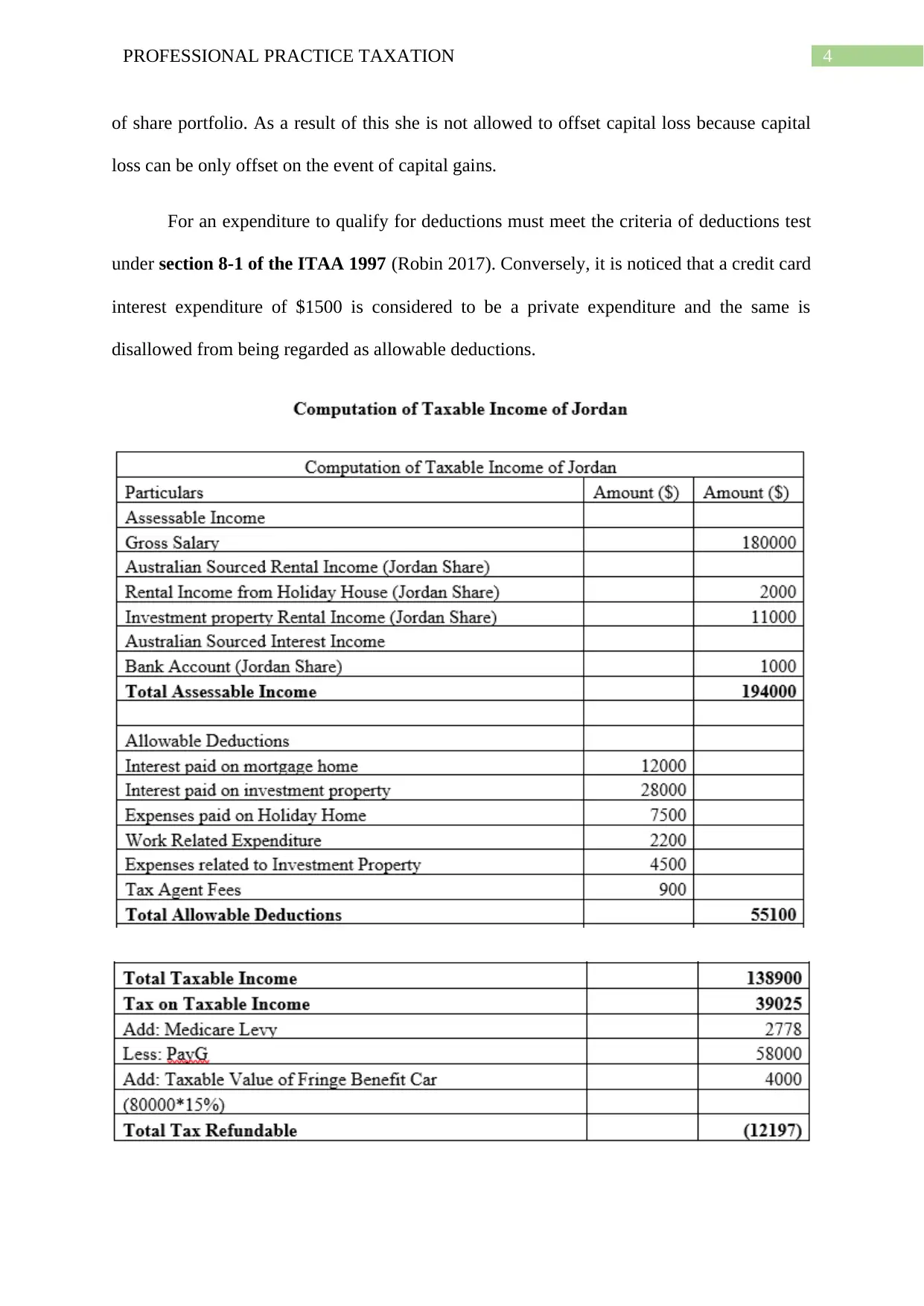
4PROFESSIONAL PRACTICE TAXATION
of share portfolio. As a result of this she is not allowed to offset capital loss because capital
loss can be only offset on the event of capital gains.
For an expenditure to qualify for deductions must meet the criteria of deductions test
under section 8-1 of the ITAA 1997 (Robin 2017). Conversely, it is noticed that a credit card
interest expenditure of $1500 is considered to be a private expenditure and the same is
disallowed from being regarded as allowable deductions.
of share portfolio. As a result of this she is not allowed to offset capital loss because capital
loss can be only offset on the event of capital gains.
For an expenditure to qualify for deductions must meet the criteria of deductions test
under section 8-1 of the ITAA 1997 (Robin 2017). Conversely, it is noticed that a credit card
interest expenditure of $1500 is considered to be a private expenditure and the same is
disallowed from being regarded as allowable deductions.
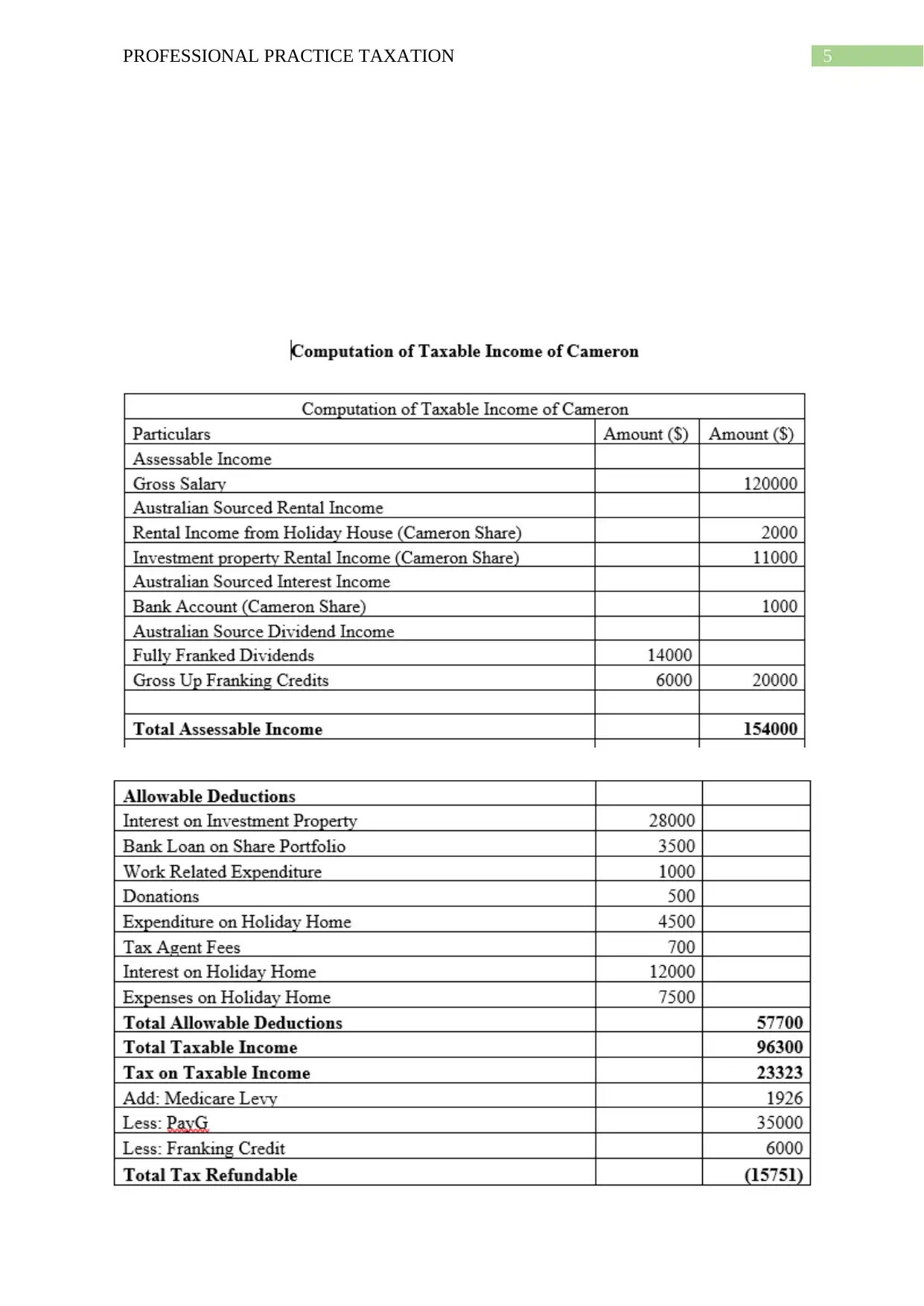
5PROFESSIONAL PRACTICE TAXATION
⊘ This is a preview!⊘
Do you want full access?
Subscribe today to unlock all pages.

Trusted by 1+ million students worldwide
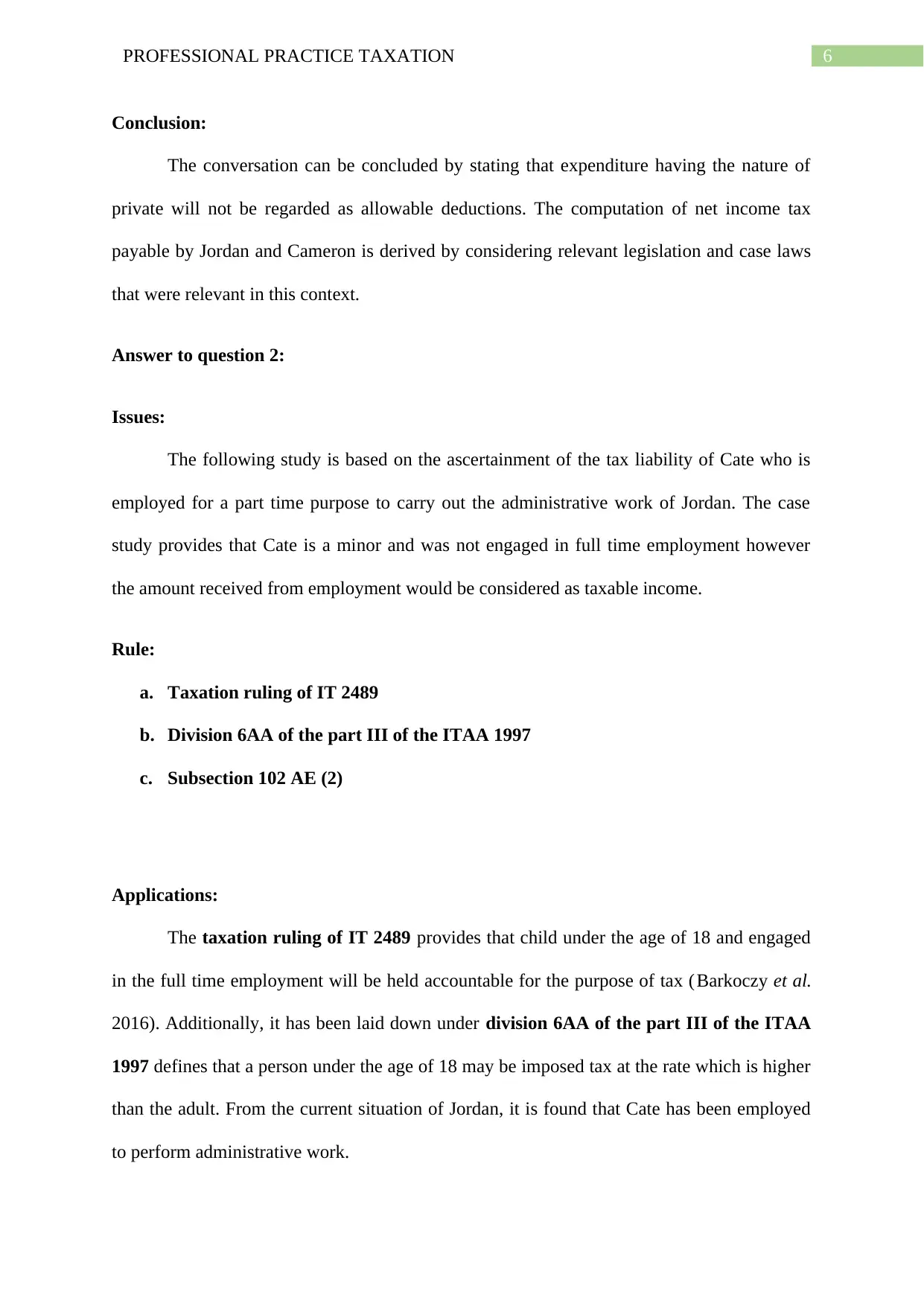
6PROFESSIONAL PRACTICE TAXATION
Conclusion:
The conversation can be concluded by stating that expenditure having the nature of
private will not be regarded as allowable deductions. The computation of net income tax
payable by Jordan and Cameron is derived by considering relevant legislation and case laws
that were relevant in this context.
Answer to question 2:
Issues:
The following study is based on the ascertainment of the tax liability of Cate who is
employed for a part time purpose to carry out the administrative work of Jordan. The case
study provides that Cate is a minor and was not engaged in full time employment however
the amount received from employment would be considered as taxable income.
Rule:
a. Taxation ruling of IT 2489
b. Division 6AA of the part III of the ITAA 1997
c. Subsection 102 AE (2)
Applications:
The taxation ruling of IT 2489 provides that child under the age of 18 and engaged
in the full time employment will be held accountable for the purpose of tax (Barkoczy et al.
2016). Additionally, it has been laid down under division 6AA of the part III of the ITAA
1997 defines that a person under the age of 18 may be imposed tax at the rate which is higher
than the adult. From the current situation of Jordan, it is found that Cate has been employed
to perform administrative work.
Conclusion:
The conversation can be concluded by stating that expenditure having the nature of
private will not be regarded as allowable deductions. The computation of net income tax
payable by Jordan and Cameron is derived by considering relevant legislation and case laws
that were relevant in this context.
Answer to question 2:
Issues:
The following study is based on the ascertainment of the tax liability of Cate who is
employed for a part time purpose to carry out the administrative work of Jordan. The case
study provides that Cate is a minor and was not engaged in full time employment however
the amount received from employment would be considered as taxable income.
Rule:
a. Taxation ruling of IT 2489
b. Division 6AA of the part III of the ITAA 1997
c. Subsection 102 AE (2)
Applications:
The taxation ruling of IT 2489 provides that child under the age of 18 and engaged
in the full time employment will be held accountable for the purpose of tax (Barkoczy et al.
2016). Additionally, it has been laid down under division 6AA of the part III of the ITAA
1997 defines that a person under the age of 18 may be imposed tax at the rate which is higher
than the adult. From the current situation of Jordan, it is found that Cate has been employed
to perform administrative work.
Paraphrase This Document
Need a fresh take? Get an instant paraphrase of this document with our AI Paraphraser
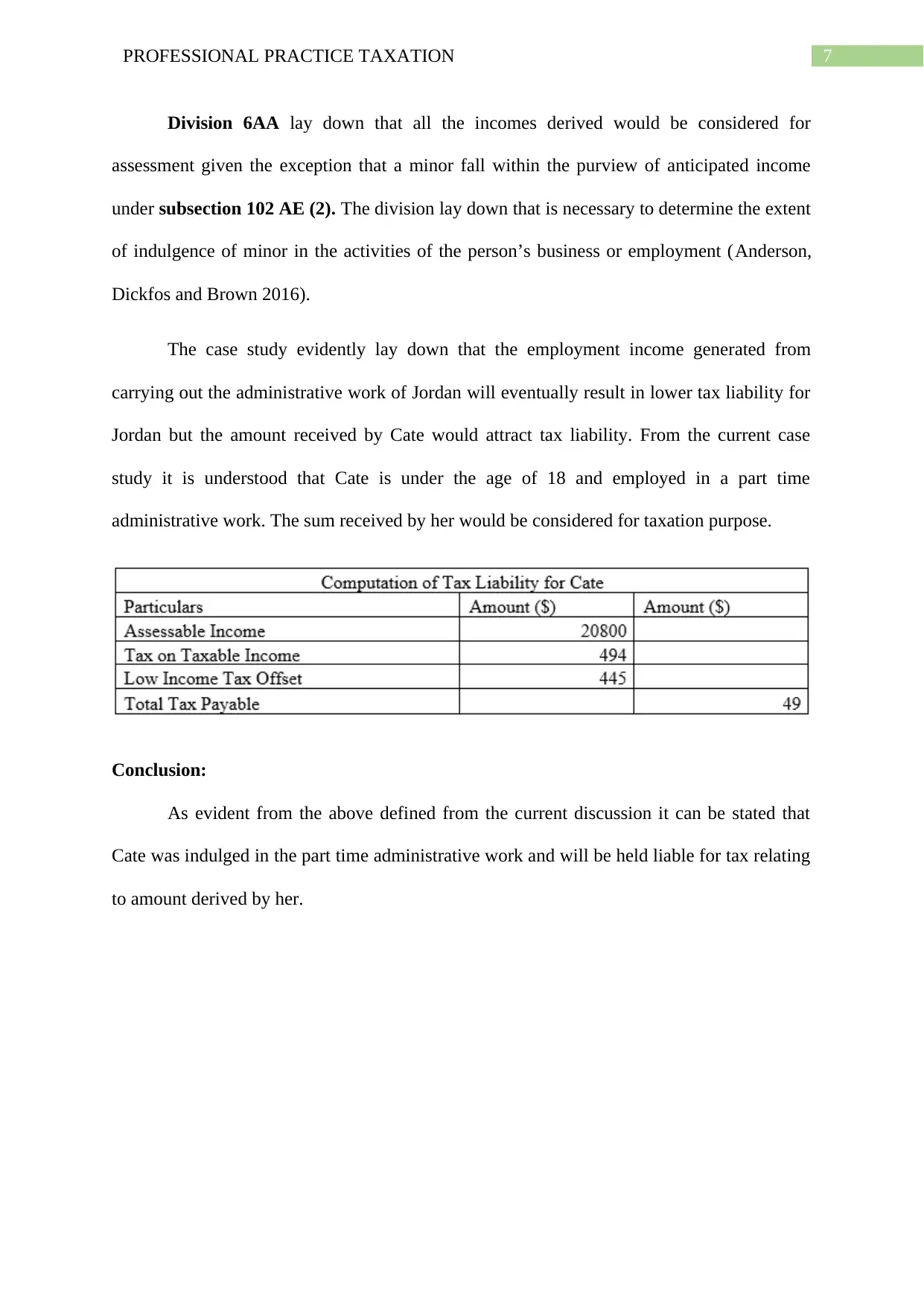
7PROFESSIONAL PRACTICE TAXATION
Division 6AA lay down that all the incomes derived would be considered for
assessment given the exception that a minor fall within the purview of anticipated income
under subsection 102 AE (2). The division lay down that is necessary to determine the extent
of indulgence of minor in the activities of the person’s business or employment (Anderson,
Dickfos and Brown 2016).
The case study evidently lay down that the employment income generated from
carrying out the administrative work of Jordan will eventually result in lower tax liability for
Jordan but the amount received by Cate would attract tax liability. From the current case
study it is understood that Cate is under the age of 18 and employed in a part time
administrative work. The sum received by her would be considered for taxation purpose.
Conclusion:
As evident from the above defined from the current discussion it can be stated that
Cate was indulged in the part time administrative work and will be held liable for tax relating
to amount derived by her.
Division 6AA lay down that all the incomes derived would be considered for
assessment given the exception that a minor fall within the purview of anticipated income
under subsection 102 AE (2). The division lay down that is necessary to determine the extent
of indulgence of minor in the activities of the person’s business or employment (Anderson,
Dickfos and Brown 2016).
The case study evidently lay down that the employment income generated from
carrying out the administrative work of Jordan will eventually result in lower tax liability for
Jordan but the amount received by Cate would attract tax liability. From the current case
study it is understood that Cate is under the age of 18 and employed in a part time
administrative work. The sum received by her would be considered for taxation purpose.
Conclusion:
As evident from the above defined from the current discussion it can be stated that
Cate was indulged in the part time administrative work and will be held liable for tax relating
to amount derived by her.
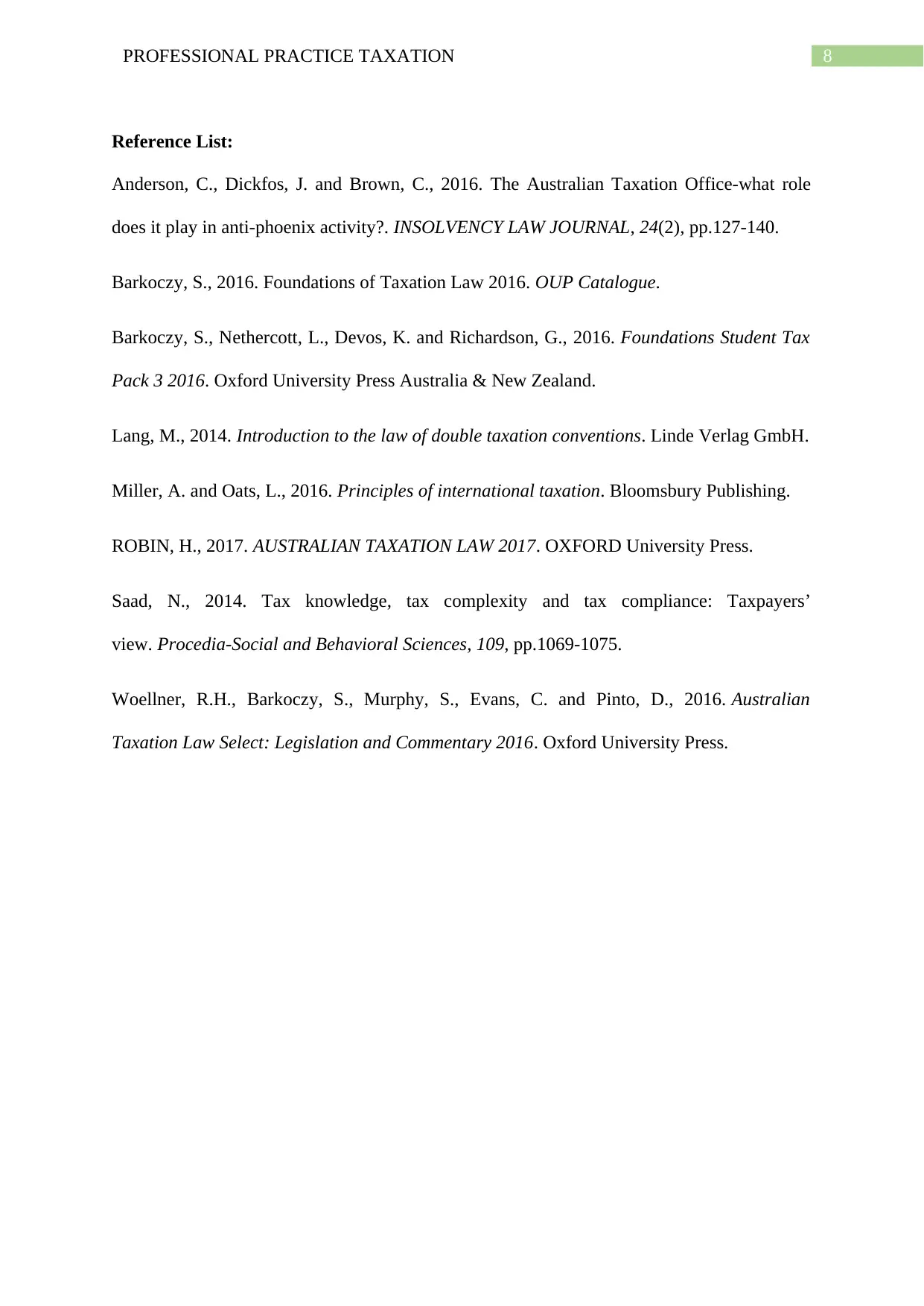
8PROFESSIONAL PRACTICE TAXATION
Reference List:
Anderson, C., Dickfos, J. and Brown, C., 2016. The Australian Taxation Office-what role
does it play in anti-phoenix activity?. INSOLVENCY LAW JOURNAL, 24(2), pp.127-140.
Barkoczy, S., 2016. Foundations of Taxation Law 2016. OUP Catalogue.
Barkoczy, S., Nethercott, L., Devos, K. and Richardson, G., 2016. Foundations Student Tax
Pack 3 2016. Oxford University Press Australia & New Zealand.
Lang, M., 2014. Introduction to the law of double taxation conventions. Linde Verlag GmbH.
Miller, A. and Oats, L., 2016. Principles of international taxation. Bloomsbury Publishing.
ROBIN, H., 2017. AUSTRALIAN TAXATION LAW 2017. OXFORD University Press.
Saad, N., 2014. Tax knowledge, tax complexity and tax compliance: Taxpayers’
view. Procedia-Social and Behavioral Sciences, 109, pp.1069-1075.
Woellner, R.H., Barkoczy, S., Murphy, S., Evans, C. and Pinto, D., 2016. Australian
Taxation Law Select: Legislation and Commentary 2016. Oxford University Press.
Reference List:
Anderson, C., Dickfos, J. and Brown, C., 2016. The Australian Taxation Office-what role
does it play in anti-phoenix activity?. INSOLVENCY LAW JOURNAL, 24(2), pp.127-140.
Barkoczy, S., 2016. Foundations of Taxation Law 2016. OUP Catalogue.
Barkoczy, S., Nethercott, L., Devos, K. and Richardson, G., 2016. Foundations Student Tax
Pack 3 2016. Oxford University Press Australia & New Zealand.
Lang, M., 2014. Introduction to the law of double taxation conventions. Linde Verlag GmbH.
Miller, A. and Oats, L., 2016. Principles of international taxation. Bloomsbury Publishing.
ROBIN, H., 2017. AUSTRALIAN TAXATION LAW 2017. OXFORD University Press.
Saad, N., 2014. Tax knowledge, tax complexity and tax compliance: Taxpayers’
view. Procedia-Social and Behavioral Sciences, 109, pp.1069-1075.
Woellner, R.H., Barkoczy, S., Murphy, S., Evans, C. and Pinto, D., 2016. Australian
Taxation Law Select: Legislation and Commentary 2016. Oxford University Press.
⊘ This is a preview!⊘
Do you want full access?
Subscribe today to unlock all pages.

Trusted by 1+ million students worldwide
1 out of 9
Related Documents
Your All-in-One AI-Powered Toolkit for Academic Success.
+13062052269
info@desklib.com
Available 24*7 on WhatsApp / Email
![[object Object]](/_next/static/media/star-bottom.7253800d.svg)
Unlock your academic potential
Copyright © 2020–2025 A2Z Services. All Rights Reserved. Developed and managed by ZUCOL.





